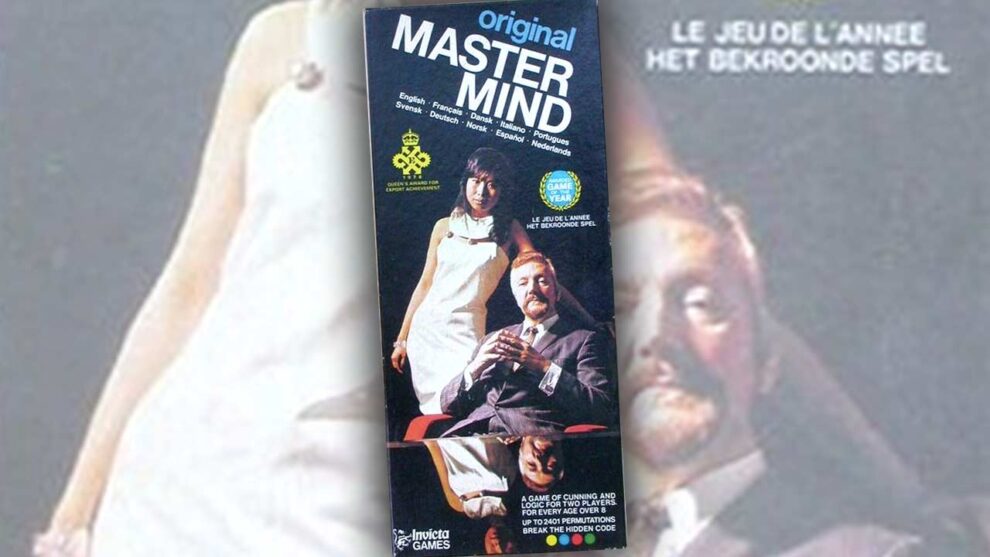For those of us of a certain age, there is only one, iconic cover of Mastermind: Bill Woodward, seated, with the fingertips of one hand touching those of his other hand, and Cecilia Fung, standing slightly behind him in her white dress, leaning, with one arm on the chair.
As a kid, I had no idea who they were, but I thought they looked intellectually serious. The kind of people who would like a challenging game. The kind of person I wanted to be.
Mastermind was produced in 1971 by Invicta Plastics. Based on an older pencil-and-paper game called Bulls and Cows, Mastermind is a code-breaking game, where one player takes the role of the Codemaker and the other is the Codebreaker.
The Codemaker starts a game by choosing four of the six colored pegs (duplicates of one color are allowed) and places them behind a shield, keeping them hidden from the Codebreaker. The Codebreaker then chooses four pegs and makes their first guess. The Codemaker awards a white marker for each guessed peg of a correct color that is in the wrong position. A black marker is given for each peg that is both the correct color and in the correct position.
Guesses continue to be made until the Code is either broken or the Codebreaker has taken ten incorrect guesses. Then the board is turned around and the Codemaker becomes the Codebreaker for the next game. Games are played in even numbers, with roles switching after each game. The number of moves to break each code are tallied and the player with the lowest score wins.
Mastermind was, for my tween-aged self, an engrossing game—provided I was the Codebreaker. Studying the pegs and markers was, unknown to me, teaching me to think logically. I’d never played a game like this and, much to my friends’ frustration, I loved to play it.
You see, there’s nothing for the Codemaster to do once they’ve set the code but to wait for the Codebreaker to make a guess. Even then, they’ll only place a few markers (hopefully) and wait for the next guess.
This, however, made it the perfect Friday night game for my father and I to play. My dad would set up the code, then go back to reading his book. He’d look up after every move, then return to his book. After I guessed the code, he’d set up another and let me continue to—silently—work to solve the code.
(Late one Friday night, when he wanted to go to bed and I was taking way too long to make a guess, he dug out an old Ragtime Quartet banjo album and played it on the stereo. Loudly. Such a great memory.)
As my friend and colleague, David, wrote in his Asymmetric Roles Step Ladder article, six years after its release, a researcher “solved” Mastermind. Subsequent research has shown that, under optimal conditions, the code can be guessed in 4.3403 moves. (With a worst case scenario being six moves—although how you take .3403 of a move, I’ll never know.)
I, however, don’t believe in dismissing a game simply because a computer has “solved” it. Apart from real world situations rarely being ‘optimal’, I’ve never thought as clearly as a computer. Had I known Mastermind was solved as a tween, it would have only made me work harder at solving the codes.
The abductive logical thinking behind Mastermind has many current counterparts. As I mentioned in my article looking at the board game origins of Wordle, Mastermind played a big part in Wordle’s history—especially the Word Mastermind edition. (Which I disliked as a tween because it was too easy to solve.)
If you have someone just beginning to explore logical thinking, I suggest you get a copy (or two, so you both can play at the same time!) of Mastermind. From experience, I can attest it is an approachable, fun place to start.










